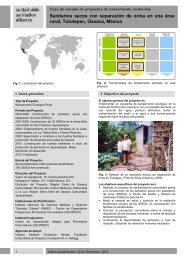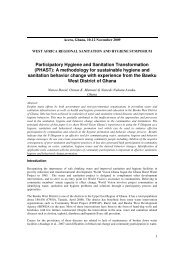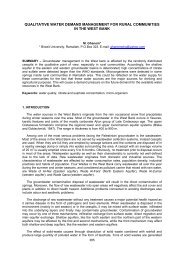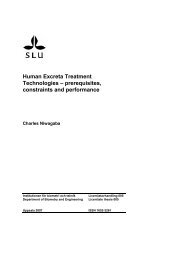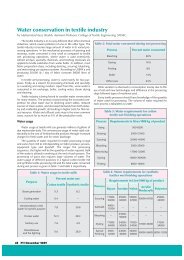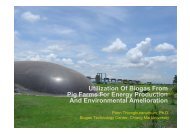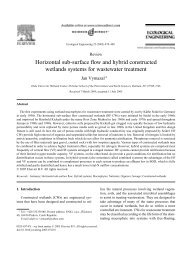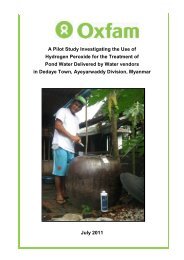Fertigation: Optimizing the Utilization of Water and Nutrients - SSWM
Fertigation: Optimizing the Utilization of Water and Nutrients - SSWM
Fertigation: Optimizing the Utilization of Water and Nutrients - SSWM
Create successful ePaper yourself
Turn your PDF publications into a flip-book with our unique Google optimized e-Paper software.
practices regarded s<strong>and</strong> dunes as non-‐agricultural soils, but <strong>the</strong> introduction <strong>of</strong><br />
fertigation turned desert s<strong>and</strong> dunes into productive agricultural soils (Kafkafi,<br />
1994). The most important aspect <strong>of</strong> fertigation, globally, is that it <strong>of</strong>fers <strong>the</strong><br />
possibility to exp<strong>and</strong> human activities into areas never before used for irrigation.<br />
The need to saving water in <strong>the</strong> traditional areas <strong>of</strong> irrigation, <strong>and</strong> <strong>the</strong> loss <strong>of</strong><br />
existing productive fields in <strong>the</strong> face <strong>of</strong> urban growth could provide <strong>the</strong> stimulus<br />
to move water <strong>and</strong> agricultural production to desert areas.<br />
Nitrate (NO3-‐-‐N) is highly mobile <strong>and</strong> is more likely to be lost through surface<br />
run<strong>of</strong>f, denitrification during flood irrigation, <strong>and</strong> leaching. In trickle irrigation,<br />
ponding under <strong>the</strong> tricklers, especially in clay soils, creates an oxygen-‐deprived<br />
space in which denitrification is observed during <strong>the</strong> irrigation cycle (Bar Yosef,<br />
1999). The rate <strong>of</strong> water discharge from a dripper should not exceed <strong>the</strong> rate <strong>of</strong><br />
water entry into <strong>the</strong> soil from a point source. Hydrolysis <strong>of</strong> applied urea can<br />
result in ammonia toxicity <strong>and</strong> losses in <strong>the</strong> form <strong>of</strong> gaseous NH3, but<br />
acidification <strong>of</strong> <strong>the</strong> irrigation water prevents such direct losses <strong>of</strong> ammonia from<br />
urea fertilizers.<br />
Added phosphate is adsorbed or precipitated in <strong>the</strong> soil, leading to a rapid<br />
decline in <strong>the</strong> water-‐soluble phosphate concentration in <strong>the</strong> soil solution.<br />
Movement <strong>of</strong> phosphate is impeded because <strong>of</strong> retention by soil oxides,<br />
carbonates <strong>and</strong> clay minerals. Application <strong>of</strong> P via drip irrigation is more<br />
efficient than via sprinkler irrigation or broadcasting, because fertigation<br />
supplies P directly into <strong>the</strong> active roots zone, which enables its immediate<br />
uptake, before it undergoes drying <strong>and</strong> irreversible fixation in <strong>the</strong> soil.<br />
Root growth<br />
To achieve optimum plant growth, <strong>the</strong> root zone must be well supplied with<br />
water, nutrients <strong>and</strong> oxygen, <strong>and</strong> must suffer minimal soil compaction.<br />
Maintenance <strong>of</strong> <strong>the</strong> water potential by frequent irrigation at continuous low<br />
water tension, especially in clay soils, might lead to a sub-‐optimal supply <strong>of</strong><br />
oxygen in <strong>the</strong> root zone (Silberbush et al., 1979). Roots respond within minutes<br />
to a reduction in oxygen supply by cessation <strong>of</strong> root extension, <strong>and</strong> <strong>the</strong><br />
elongation zone <strong>of</strong> a cotton root, for example, dies after only 30 min without<br />
oxygen (Klepper, 1981). Under drip irrigation, oxygen might be excluded from<br />
<strong>the</strong> saturation zone when <strong>the</strong>re is a continuous supply <strong>of</strong> water at high rates, but<br />
a slow flow rate may maintain optimal moisture <strong>and</strong> oxygen regimes in <strong>the</strong> wet<br />
soil volume.<br />
The nitrate-‐to-‐ammonium ratio affects <strong>the</strong> development <strong>of</strong> <strong>the</strong> root system: high<br />
concentrations <strong>of</strong> ammonium are deleterious to root growth, especially when<br />
19



